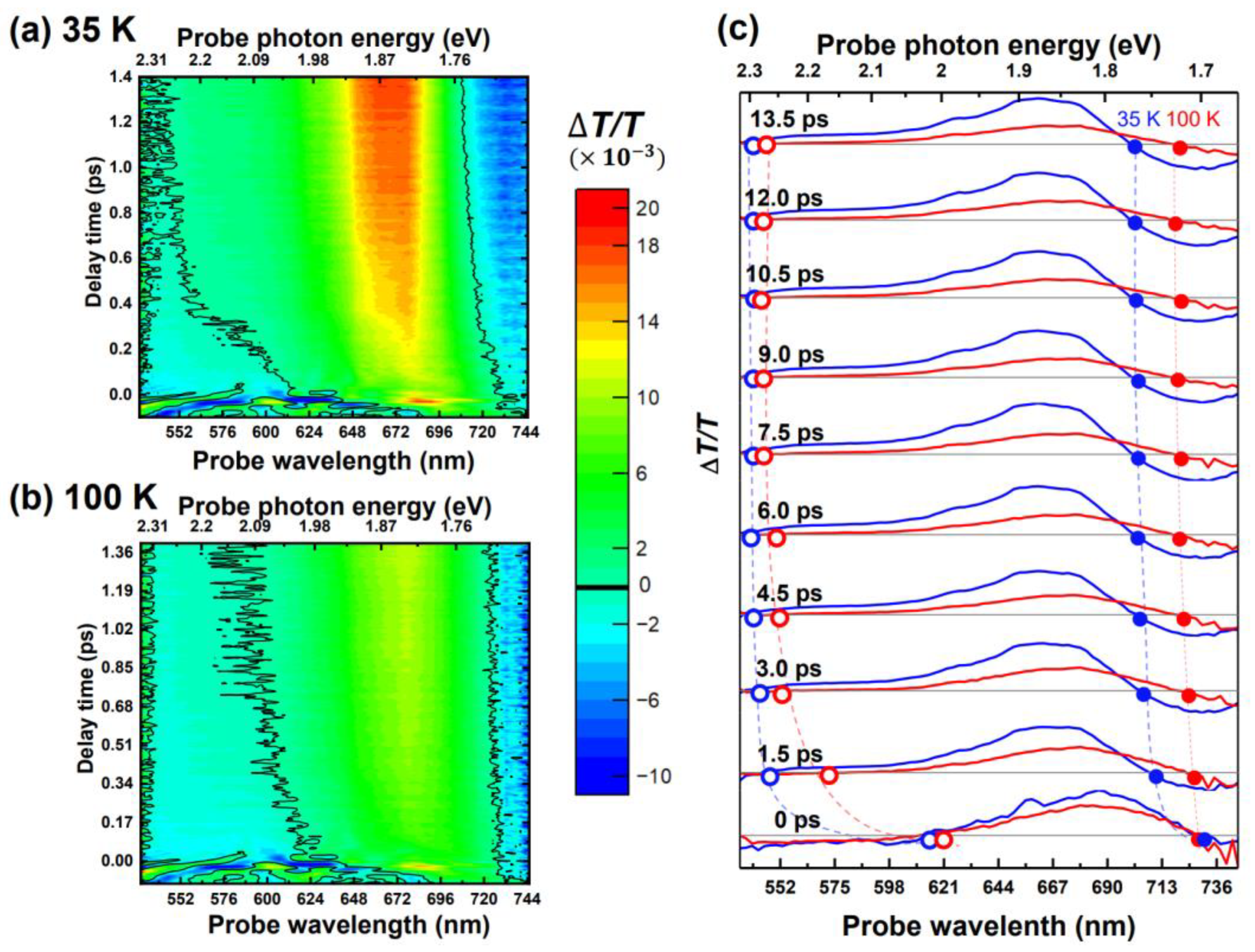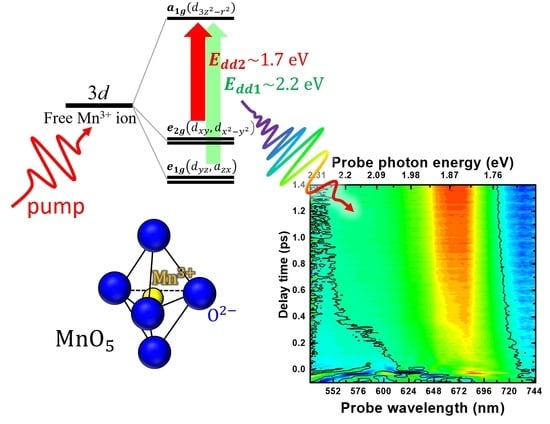Energy-Resolved Ultrafast Spectroscopic Investigation on the Spin-Coupled Electronic States in Multiferroic Hexagonal HoMnO3
Abstract
:1. Introduction
2. Materials and Methods
3. Results and Discussion
4. Conclusions
Supplementary Materials
Author Contributions
Funding
Institutional Review Board Statement
Informed Consent Statement
Data Availability Statement
Conflicts of Interest
References
- Nan, C.W.; Bichurin, M.I.; Dong, S.; Viehland, D.; Srinivasan, G. Multiferroic magnetoelectric composites: Historical perspective, status, and future directions. J. Appl. Phys. 2008, 103, 031101. [Google Scholar] [CrossRef]
- Khomskii, D. Multiferroics: Different ways to combine magnetism and ferroelectricity. J. Magn. Magn. Mater. 2006, 306, 1–8. [Google Scholar] [CrossRef] [Green Version]
- Prellier, W.; Singh, M.P.; Murugavel, P. The single-phase multiferroic oxides: From bulk to thin film. J. Phys. Condens. Matter 2005, 17, R803–R832. [Google Scholar] [CrossRef]
- Lorenz, B. Hexagonal Manganites—(RMnO3): Class (I) Multiferroics with strong coupling of magnetism and ferroelectricity. ISRN Condens. Matter Phys. 2013, 2013, 497073. [Google Scholar] [CrossRef] [Green Version]
- Van Aken, B.B.; Palstra, T.T.; Filippetti, A.; Spaldin, N.A. The origin of ferroelectricity in magnetoelectric YMnO3. Nat. Mater. 2004, 3, 164–170. [Google Scholar] [CrossRef] [Green Version]
- Lonkai, T.; Tomuta, D.G.; Hoffmann, J.-U.; Schneider, R.; Hohlwein, D.; Ihringer, J. Magnetic two-dimensional short-range order in hexagonal manganites. J. Appl. Phys. 2003, 93, 8191–8193. [Google Scholar] [CrossRef]
- Orlenko, E.V.; Ershova, E.V.; Orlenko, F.E. Invariant exchange perturbation theory for multicenter systems and its application to the calculation of magnetic chains in manganites. J. Exp. Theor. Phys. 2013, 117, 674–690. [Google Scholar] [CrossRef]
- Fiebig, M.; Fröhlich, D.; Kohn, K.; Leute, S.; Lottermoser, T.; Pavlov, V.V.; Pisarev, R.V. Determination of the magnetic symmetry of hexagonal manganites by second harmonic generation. Phys. Rev. Lett. 2000, 84, 5620–5623. [Google Scholar] [CrossRef]
- Rai, R.C.; Cao, J.; Musfeldt, J.L.; Kim, S.B.; Cheong, S.W.; Wei, X. Spin-charge coupling and the high-energy magnetodielectric effect in hexagonal HoMnO3. Phys. Rev. B 2007, 75, 184414. [Google Scholar] [CrossRef] [Green Version]
- Souchkov, A.B.; Simpson, J.R.; Quijada, M.; Ishibashi, H.; Hur, N.; Ahn, J.S.; Cheong, S.W.; Millis, A.J.; Drew, H.D. Exchange interaction effects on the optical properties of LiMnO3. Phys. Rev. Lett. 2003, 91, 027203. [Google Scholar] [CrossRef] [Green Version]
- Choi, W.S.; Kim, D.G.; Seo, S.S.A.; Moon, S.J.; Lee, D.; Lee, J.H.; Lee, H.S.; Cho, D.Y.; Lee, Y.S.; Murugavel, P.; et al. Electronic structures of hexagonal RMnO3 (R = Gd, Tb, Dy, and Ho) thin films: Optical spectroscopy and first-principles calculations. Phys. Rev. B 2008, 77, 045137. [Google Scholar] [CrossRef] [Green Version]
- Choi, W.S.; Moon, S.J.; Seo, S.S.A.; Lee, D.; Lee, J.H.; Murugavel, P.; Noh, T.W.; Lee, Y.S. Optical spectroscopic investigation on the coupling of electronic and magnetic structure in multiferroic hexagonal RMnO3 (R = Gd, Tb, Dy, and Ho) thin films. Phys. Rev. B 2008, 78, 054440. [Google Scholar] [CrossRef] [Green Version]
- Degenhardt, C.; Fiebig, M.; Fröhlich, D.; Lottermoser, T.; Pisarev, R.V. Nonlinear optical spectroscopy of electronic transitions in hexagonal manganites. Appl. Phys. B 2001, 73, 139–144. [Google Scholar] [CrossRef]
- Dagotto, E.; Hotta, T.; Moreo, A. Colossal magnetoresistant materials: The key role of phase separation. Phys. Rep. 2001, 344, 1–153. [Google Scholar] [CrossRef] [Green Version]
- Loktev, V.M.; Pogorelov, Y.G. Peculiar physical properties and the colossal magnetoresistance of manganites. Low Temp. Phys. 2000, 26, 171–193. [Google Scholar] [CrossRef]
- Orlova, T.S.; Laval, J.Y.; Monod, P.; Bassoul, P.; Noudem, J.G.; Orlenko, E.V. Influence of Mn-site doping on charge and orbital ordering in La1/3Ca2/3Mn1-yMyO3 manganites (M = Ni, Ga). Phys. Rev. B 2009, 79, 134407. [Google Scholar] [CrossRef]
- Lee, S.; Pirogov, A.; Kang, M.; Jang, K.H.; Yonemura, M.; Kamiyama, T.; Cheong, S.W.; Gozzo, F.; Shin, N.; Kimura, H.; et al. Giant magneto-elastic coupling in multiferroic hexagonal manganites. Nature 2008, 451, 805–808. [Google Scholar] [CrossRef]
- Lee, S.; Pirogov, A.; Han, J.H.; Park, J.G.; Hoshikawa, A.; Kamiyama, T. Direct observation of a coupling between spin, lattice and electric dipole moment in multiferroic YMnO3. Phys. Rev. B 2005, 71, 180413. [Google Scholar] [CrossRef]
- Vermette, J.; Jandl, S.; Mukhin, A.A.; Ivanov, V.Y.; Balbashov, A.; Gospodinov, M.M.; Pinsard-Gaudart, L. Raman study of the antiferromagnetic phase transitions in hexagonal Y MnO3 and LuMnO3. J. Phys. Condens. Matter 2010, 22, 356002. [Google Scholar] [CrossRef]
- Litvinchuk, A.P.; Iliev, M.N.; Popov, V.N.; Gospodinov, M.M. Raman and infrared-active phonons in hexagonal HoMnO3 single crystals: Magnetic ordering effects. J. Phys. Condens. Matter 2004, 16, 809–819. [Google Scholar] [CrossRef] [Green Version]
- Basistyy, R.; Stanislavchuk, T.N.; Sirenko, A.A.; Litvinchuk, A.P.; Kotelyanskii, M.; Carr, G.L.; Lee, N.; Wang, X.; Cheong, S.W. Infrared-active optical phonons and magnetic excitations in the hexagonal manganites RMnO3, (R = Er, Tm, Yb, and Lu). Phys. Rev. B 2014, 90, 024307. [Google Scholar] [CrossRef]
- Wu, K.H.; Hsu, T.Y.; Shih, H.C.; Chen, Y.J.; Luo, C.W.; Uen, T.M.; Lin, J.Y.; Juang, J.Y.; Kobayashi, T. Ultrafast optical probes of polaron dynamics in La0.7Ca0.3MnO3 thin films. J. Appl. Phys. 2009, 105, 043901. [Google Scholar] [CrossRef]
- Luo, C.W.; Chen, M.H.; Chen, S.P.; Wu, K.H.; Juang, J.Y.; Lin, J.Y.; Uen, T.M.; Gou, Y.S. Spatial symmetry of the superconducting gap of YBa2Cu3O7–δ obtained from femtosecond spectroscopy. Phys. Rev. B 2003, 68, 220508. [Google Scholar] [CrossRef] [Green Version]
- Luo, C.W.; Wu, I.H.; Cheng, P.C.; Lin, J.Y.; Wu, K.H.; Uen, T.M.; Juang, J.Y.; Kobayashi, T.; Wen, Y.C.; Huang, T.W.; et al. Ultrafast dynamics and phonon softening in Fe1+ySe1–xTex single crystals. New J. Phys. 2012, 14, 103053. [Google Scholar] [CrossRef]
- Chen, H.J.; Wu, K.H.; Luo, C.W.; Uen, T.M.; Juang, J.Y.; Lin, J.Y.; Kobayashi, T.; Yang, H.D.; Sankar, R.; Chou, F.C.; et al. Phonon dynamics in CuxBi2Se3 (x = 0, 0.1, 0.125) and Bi2Se2 crystals studied using femtosecond spectroscopy. Appl. Phys. Lett. 2012, 101, 121912. [Google Scholar] [CrossRef] [Green Version]
- Luo, C.W.; Chung Cheng, P.; Wang, S.H.; Chiang, J.C.; Lin, J.Y.; Wu, K.H.; Juang, J.Y.; Chareev, D.A.; Volkova, O.S.; Vasiliev, A.N. Unveiling the hidden nematicity and spin subsystem in FeSe. NPJ Quantum Mater. 2017, 2, 32. [Google Scholar] [CrossRef] [Green Version]
- Qi, J.; Yan, L.; Zhou, H.D.; Zhu, J.X.; Trugman, S.A.; Taylor, A.J.; Jia, Q.X.; Prasankumar, R.P. Coexistence of coupled magnetic phases in epitaxial TbMnO3 films revealed by ultrafast optical spectroscopy. Appl. Phys. Lett. 2012, 101, 122904. [Google Scholar] [CrossRef] [Green Version]
- Wu, K.H.; Chen, H.J.; Hsieh, C.C.; Luo, C.W.; Uen, T.M.; Lin, J.Y.; Juang, J.Y. Epitaxial-strain effects on electronic structure and magnetic properties of hexagonal YMnO3 thin films studied by femtosecond spectroscopy. J. Supercond. Nov. Magn. 2013, 26, 801. [Google Scholar] [CrossRef] [Green Version]
- Shih, H.C.; Lin, T.H.; Luo, C.W.; Lin, J.Y.; Uen, T.M.; Juang, J.Y.; Wu, K.H.; Lee, J.M.; Chen, J.M.; Kobayashi, T. Magnetization dynamics and the Mn3+d−d excitation of hexagonal HoMnO3 single crystals using wavelength-tunable time-resolved femtosecond spectroscopy. Phys. Rev. B 2009, 80, 024427. [Google Scholar] [CrossRef] [Green Version]
- Wu, K.H.; Chen, H.J.; Chen, Y.T.; Hsieh, C.C.; Luo, C.W.; Uen, T.M.; Juang, J.Y.; Lin, J.Y.; Kobayashi, T.; Gospodinov, M. Marked enhancement of Néel temperature in strained YMnO3 thin films probed by femtosecond spectroscopy. EPL (Europhys. Lett.) 2011, 94, 27006. [Google Scholar] [CrossRef]
- Shih, H.C.; Chen, L.Y.; Luo, C.W.; Wu, K.H.; Lin, J.Y.; Juang, J.Y.; Uen, T.M.; Lee, J.M.; Chen, J.M.; Kobayashi, T. Ultrafast thermoelastic dynamics of HoMnO3 single crystals derived from femtosecond optical pump–probe spectroscopy. New J. Phys. 2011, 13, 053003. [Google Scholar] [CrossRef]
- Fröhlich, D.; Leute, S.; Pavlov, V.V.; Pisarev, R.V. Nonlinear optical spectroscopy of the two-order-parameter compound YMnO3. Phys. Rev. Lett. 1998, 81, 3239–3242. [Google Scholar] [CrossRef]
- Wang, Y.T.; Luo, C.W.; Kobayashi, T. Understanding multiferroic hexagonal manganites by static and ultrafast optical spectroscopy. Adv. Condens. Matter Phys. 2013, 2013, 104806. [Google Scholar] [CrossRef] [Green Version]
- Kobayashi, T.; Baltuska, A. Sub-5 fs pulse generation from a noncollinear optical parametric amplifier. Meas. Sci. Technol. 2002, 13, 1671–1682. [Google Scholar] [CrossRef]
- Shirakawa, A.; Sakane, I.; Takasaka, M.; Kobayashi, T. Sub-5-fs visible pulse generation by pulse-front-matched noncollinear optical parametric amplification. Appl. Phys. Lett. 1999, 74, 2268–2270. [Google Scholar] [CrossRef]
- Luo, C.W.; Wang, Y.T.; Yabushita, A.; Kobayashi, T. Ultrabroadband time-resolved spectroscopy in novel types of condensed matter. Optica 2016, 3, 82–92. [Google Scholar] [CrossRef]
- Kimel, A.V.; Pisarev, R.V.; Bentivegna, F.; Rasing, T. Time-resolved nonlinear optical spectroscopy of Mn3+ ions in rare-earth hexagonal manganites RMnO3 (R = Sc, Y, Er). Phys. Rev. B 2001, 64, 201103. [Google Scholar] [CrossRef] [Green Version]
- Satoh, T.; Van Aken, B.B.; Duong, N.P.; Lottermoser, T.; Fiebig, M. Ultrafast spin and lattice dynamics in antiferromagnetic Cr2O3. Phys. Rev. B 2007, 75, 155406. [Google Scholar] [CrossRef] [Green Version]
- Sheu, Y.M.; Trugman, S.A.; Park, Y.S.; Lee, S.; Yi, H.T.; Cheong, S.W.; Jia, Q.X.; Taylor, A.J.; Prasankumar, R.P. Ultrafast carrier dynamics and radiative recombination in multiferroic BiFeO3. Appl. Phys. Lett. 2012, 100, 242904. [Google Scholar] [CrossRef] [Green Version]
- Talbayev, D.; Lee, J.; Trugman, S.A.; Zhang, C.L.; Cheong, S.W.; Averitt, R.D.; Taylor, A.J.; Prasankumar, R.P. Spin-dependent polaron formation dynamics in Eu0.75Y0.25MnO3 probed by femtosecond pump-probe spectroscopy. Phys. Rev. B 2015, 91, 064420. [Google Scholar] [CrossRef] [Green Version]
- Fukunaga, K.; Hashimoto, M.; Kunugita, H.; Kamimura, J.; Kikuchi, A.; Kishino, K.; Ema, K. Energy- and density-dependent dynamics of photoexcited carriers in InN films. Appl. Phys. Lett. 2009, 95, 232114. [Google Scholar] [CrossRef]
- Wall, S.; Prabhakaran, D.; Boothroyd, A.T.; Cavalleri, A. Ultrafast coupling between light, coherent lattice vibrations, and the magnetic structure of semicovalent LaMnO3. Phys. Rev. Lett. 2009, 103, 097402. [Google Scholar] [CrossRef] [PubMed] [Green Version]
- Nakayama, M.; Furukawa, Y.; Maeda, K.; Yoshimura, T.; Uga, H.; Fujimura, N. Correlation between the intra-atomic Mn3+ photoluminescence and antiferromagnetic transition in an YMnO3 epitaxial film. Appl. Phys. Express 2014, 7, 023002. [Google Scholar] [CrossRef]
- Ogasawara, T.; Ohgushi, K.; Tomioka, Y.; Takahashi, K.S.; Okamoto, H.; Kawasaki, M.; Tokura, Y. General features of photoinduced spin dynamics in ferromagnetic and ferrimagnetic compounds. Phys. Rev. Lett. 2005, 94, 087202. [Google Scholar] [CrossRef] [PubMed]
- Toulouse, C.; Liu, J.; Gallais, Y.; Measson, M.A.; Sacuto, A.; Cazayous, M.; Chaix, L.; Simonet, V.; de Brion, S.; Pinsard-Godart, L.; et al. Lattice and spin excitations in multiferroic h-YMnO3. Phys. Rev. B 2014, 89, 094415. [Google Scholar] [CrossRef] [Green Version]
- Fiebig, M.; Degenhardt, C.; Pisarev, R.V. Interaction of frustrated magnetic sublattices in ErMnO3. Phys. Rev. Lett. 2001, 88, 027203. [Google Scholar] [CrossRef] [PubMed]




Publisher’s Note: MDPI stays neutral with regard to jurisdictional claims in published maps and institutional affiliations. |
© 2022 by the authors. Licensee MDPI, Basel, Switzerland. This article is an open access article distributed under the terms and conditions of the Creative Commons Attribution (CC BY) license (https://creativecommons.org/licenses/by/4.0/).
Share and Cite
Huang, W.-H.; Wei, H.-K.; Quyen, N.N.; Yang, P.-T.; Cheng, Y.-C.; Wang, Y.-T.; Ko, Y.-K.; Tu, C.-M.; Yabushita, A.; Luo, C.-W. Energy-Resolved Ultrafast Spectroscopic Investigation on the Spin-Coupled Electronic States in Multiferroic Hexagonal HoMnO3. Materials 2022, 15, 5188. https://doi.org/10.3390/ma15155188
Huang W-H, Wei H-K, Quyen NN, Yang P-T, Cheng Y-C, Wang Y-T, Ko Y-K, Tu C-M, Yabushita A, Luo C-W. Energy-Resolved Ultrafast Spectroscopic Investigation on the Spin-Coupled Electronic States in Multiferroic Hexagonal HoMnO3. Materials. 2022; 15(15):5188. https://doi.org/10.3390/ma15155188
Chicago/Turabian StyleHuang, Wei-Hong, Hao-Keng Wei, Nguyen Nhat Quyen, Pei-Tsung Yang, Yi-Cheng Cheng, Yu-Ting Wang, Ying-Kuan Ko, Chien-Ming Tu, Atsushi Yabushita, and Chih-Wei Luo. 2022. "Energy-Resolved Ultrafast Spectroscopic Investigation on the Spin-Coupled Electronic States in Multiferroic Hexagonal HoMnO3" Materials 15, no. 15: 5188. https://doi.org/10.3390/ma15155188






